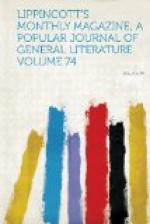The town proper of Bhopal is enclosed by a much—decayed wall of masonry some two miles in circuit, within which is a fort, similar both in its condition and material to the wall. Outside these limits is a large commercial quarter (gunge). The beautiful lake running off past the town to the south is said to be artificial in its origin, and to have been produced at the instance of Bho Pal, the minister of King Bohoje, as long ago as the sixth century, by damming up the waters of the Bess (or Besali) River, for the purpose of converting an arid section into fertile land. It is still called the Bhopal Tal.
[Illustration: A NAUTCH-GIRL (OR BAYADERE) OF ULWUR.]
If this were a ponderous folio of travels, one could detail the pleasures and polite attentions of one’s Bhopalese host; of the social utter-pan; of the sprinklings with rose-water; of the dreamy talks over fragrant hookahs; of the wanderings among bazaars filled with moving crowds of people hailing from all the ports that lie between Persia and the Gondwana; of the fetes where the nautch-girl of Baroda contended in graceful emulation with the nautch-girl of Ulwur, and the cathacks (or male dancers) with both; of elegantly-perfumed Bhopalese young men; of the palaces of nobles guarded by soldiers whose accoutrements ranged from the musket to the morion; of the Moharum, when the Mohammedan celebrates the New Year. But what would you have? A sketch is a sketch. We have got only to the heart of India: the head and the whole prodigious eastern side are not yet reached. It is time one were off for Jhansi.
At Bioura we encountered modern civilization again in the shape of the south-west branch of the Grand Trunk road, which leads off from the main stem at Agra. The Grand Trunk is not a railroad, but a firm and smooth highway, with which the English have united Calcutta to the North-west Provinces and to the west of India. Much of this great roadway is metaled with kunkur, an oolitic limestone found near the surface of the soil in Hindustan; and all Anglo-India laughed at the joke of an irreverent punster who, apropos of the fact that this application of kunkur to the road-bed was made under the orders of Lord William Bentinck, then governor-general, dubbed that gentleman William the Kunkurer.




